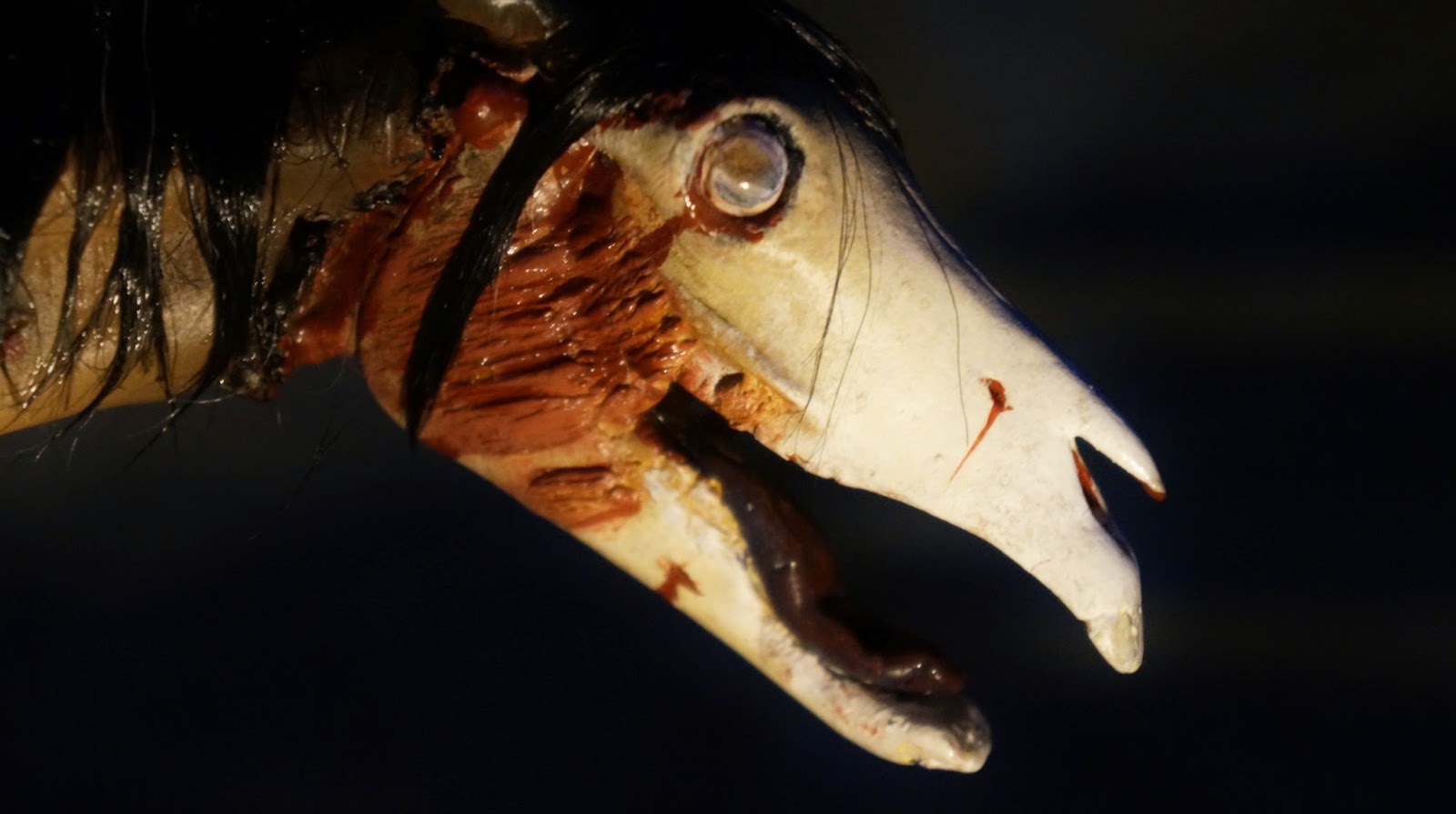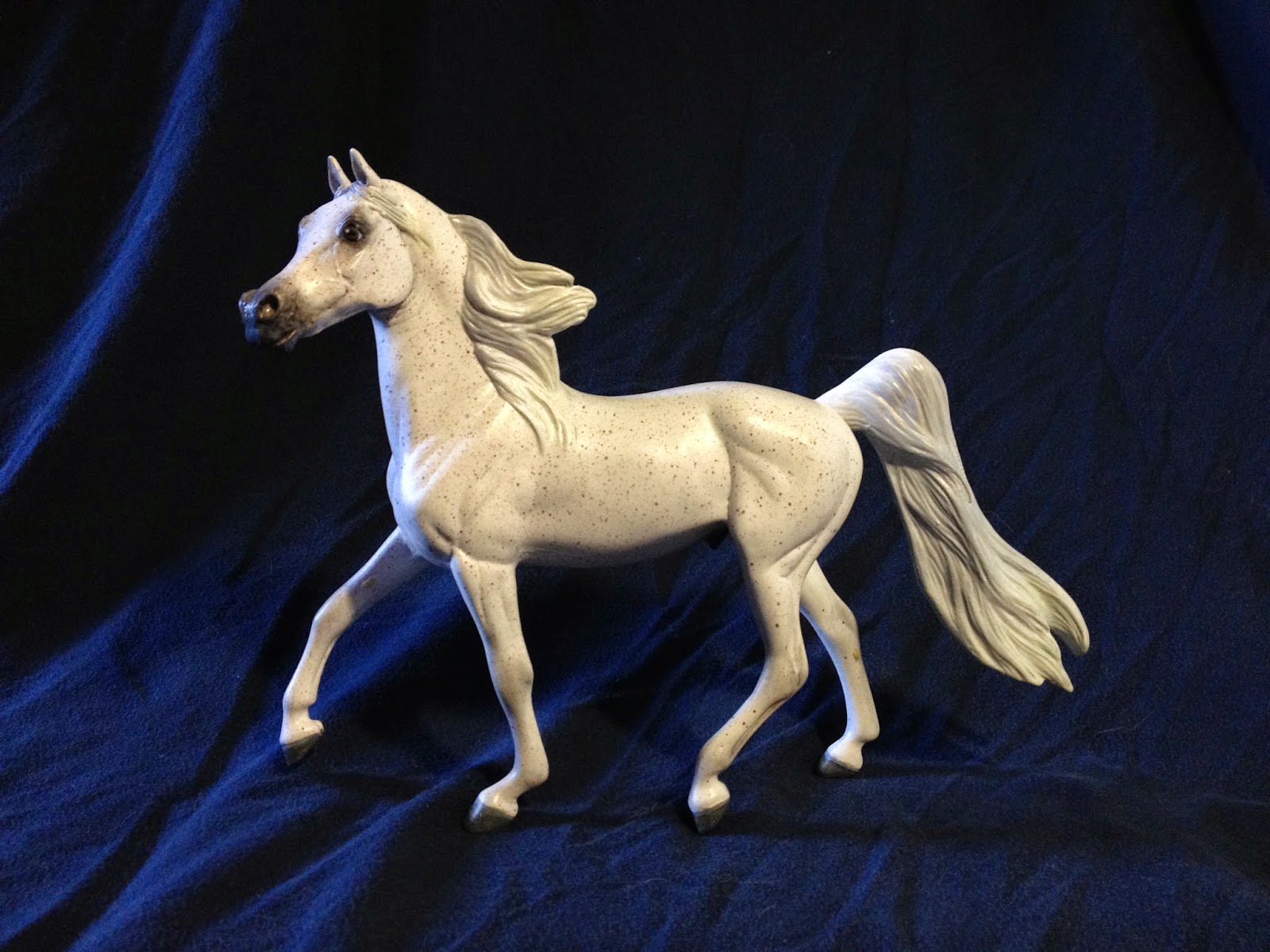I've been asked by a few people how to paint eyes, and I promised that my next custom will be the one for the tutorial. I want to apologise in advance about the quality of the photos - I wasn't using my lamp to see and this is what I get for it. I have some tweaking to do with this method and the materials I use, so another - updated - tutorial is expected in the future. I'll have clear photos then! I SWEAR.
Okay! so to start, I'm going to be a hypocrite and say "use a reference when painting eyes." I'm a hypocrite, because I didn't. You can get away without a reference if you've spent hours staring into horses' eyes (like I have,) but even still it's best to have a picture (or the real thing) at the ready for maximum realism!
I highly recommend - even push - that you use a reference for blue eyes or bi-eyes. They're a lot more complex than brown eyes, so it's a good idea to reference something. I haven't owned a horse in over a year and the photos I have of my first horse's eyes aren't the best, but why not put them to use since they're the ones I mentally referenced?
The biggest thing to keep in mind is that horses don't have circular pupils like we do. That's one thing I've seen in some customs - especially from beginning customizers. People paint circular pupils on horses when they're not circular at all! They're oval, and sometimes they're just three dots in a line.
As with any eye, the bottom is usually lighter than the top, since it doesn't have as much shadowing from the eye lid. We want to keep this in mind when we paint, and this is why I recommend using a reference.
Okay, the lecture is over, let's get to work!
Depending on what colour of eye you're doing, you'll need at least 4 different colours - the base, the highlight, the pupil, and white. You can mix the black (pupil) with some of the base colour for the shading.
You'll also want a very fine brush. I use a 0000 liner I got at michael's for $4. It may be expensive for one dinky little paintbrush, but boy does it make a difference!!
For glossing, you can use clear nailpolish, or mod podge. I use mod podge, because then I can choose the size of brush I use and have more control over where I'm glazing.
To start, make sure all of your custom body work is done. The horse should have its coat and this should be one of the last steps you do.
If your horse meets the criteria, then we can continue!
Start with a little drop of black paint. It literally doesn't even need to be a drop. Heck, shove the paintbrush into the bottle - there's no need to waste paint by dabbing it onto a pallet.
Then, paint the whole eye black. That's right - black. Not white. We'll get to that in the next step.
The black sets a good foundation for the rest of the paint, and gives the eye an outline. Additional "eyeliner" can be applied if the horse is a paint/pinto or has a bald face if you so desire.
Work on both eyes at a time. While you're working on the second eye, the first eye has enough time to dry so you can keep going and won't have to repeat the whole process for one eye.
Once one eye is dry, look at your model. How do you want the eyes? Are they looking forward like Dakota in my references, or are they looking a different direction? Is there any white showing at all? If yes, this is the next step.
Take some white and cream (or brown if you don't have cream, and add a little dot of yellow) and mix together to get a really light tan. This will be the sclera. Spot's eyes were looking back, so I added the white to the front corner. Grab a ref for the pose of the eye as well. Raceing/galloping/scared horses might have a white halo around the upper eyelid, while barrel racers might be looking back like this horse. It also depends on the breed - appies and paints tend to have smaller irises than other breeds, so more white shows.
Next, take the black again and refine the edge to make it more round. The sclera above was too crescent-shaped for my liking, so this step allowed me to make the edit needed.
I thought I had a photo for this. Whoops!
After that, take a bit of white and make a little line. Push it up as close to the edge of the black as you can, without completely painting out the black. This step is optional, but I've found that it makes the eye look more realistic, so I do it.
You don't have to paint the whole area white.
Then, take the black AGAIN and paint over the white, pushing the black as close to the edge of the white as you can without painting over the white. You should have a thin black and thin white line now.
I could've pushed the black up further, but I couldn't see without my glasses or contacts on so I played it safe.
Alright, now onto the colour!
take that base tone you chose and cover the rest of the eye with it. You don't have to leave a thin black line for this part, but make sure you don't paint over the white line.
Next, take your shadow colour that you mixed (or have) and paint the top half of the iris according to the eyelid. How dark your shadow is, is up to you. I wanted a medium shadow, so I made it slightly darker than the base coat. Acrylics dry darker than the colour they are when wet, so keep this in mind!
Now, take your highlight colour and paint a thin crescent on the bottom half. It's okay if it's sloppy as long as it's curved correctly.
I used the raw cream colour that I used to mix with the white for the sclera.
Then, I take the base tone and refine it so it's just a thin line that doesn't touch the pupil nor the lower eyelid. It's suspended so to speak.
Now, I add the pupil. A general rule of thumb is that the pupil should be parallel to the ground. That's something I forgot when painting these eyes, but oh well - it's just something to keep in mind for next time!
Now it's time to glaze!
Now if you would like, you can dry-dab some white on the center of the sclera to imitate roundness.
This part is up to you on what you use. You can wait until you paint the hooves and then re-seal the whole model, or you can use clear nailpolish (which is waterproof obviously) or Mod Podge which is also a sealer to glaze and seal the colour. You don't want to glaze the eyes if you're going to spray the model again. Wait until afterwards, or the matte spray may reduce the reflection of the eyes. You can skip this part if you're glossing the entire horse, since it generally won't make a difference when the whole horse is glossy.
I personally used mod podge, which has a very strong odor (even I was surprised and I'm used to the smell of ammonia) so make sure you have a window cracked if using it inside as it can be unpleasant and I can't imagine that being safe to breathe.
Take the same brush (if using mod podge - if using nailpolish, use what's given) and cover the wntire surface of the eyeball with the glaze. Try to keep it within the confines of the eyelids, or it'll look like the horse was crying or just got off a really fast rollercoaster!
Mod podge goes on white but dries clear, so there's a moment where the horse looks blind!
Wait for that to dry and admire your new, live-looking eyes!
I hope this helps! If you have any questions or ideas for future tutorials, post in the comments below!
Over and Out!












































